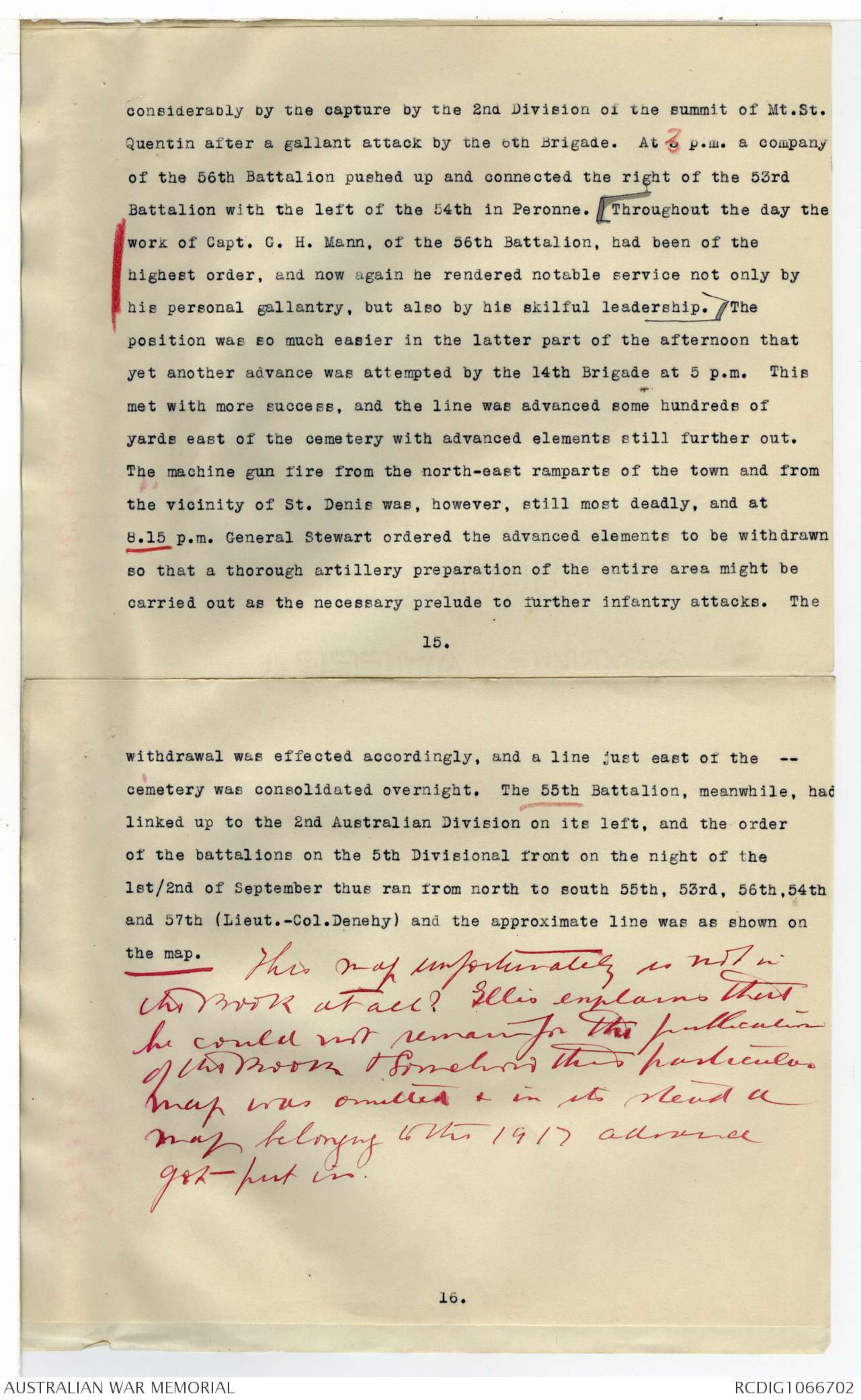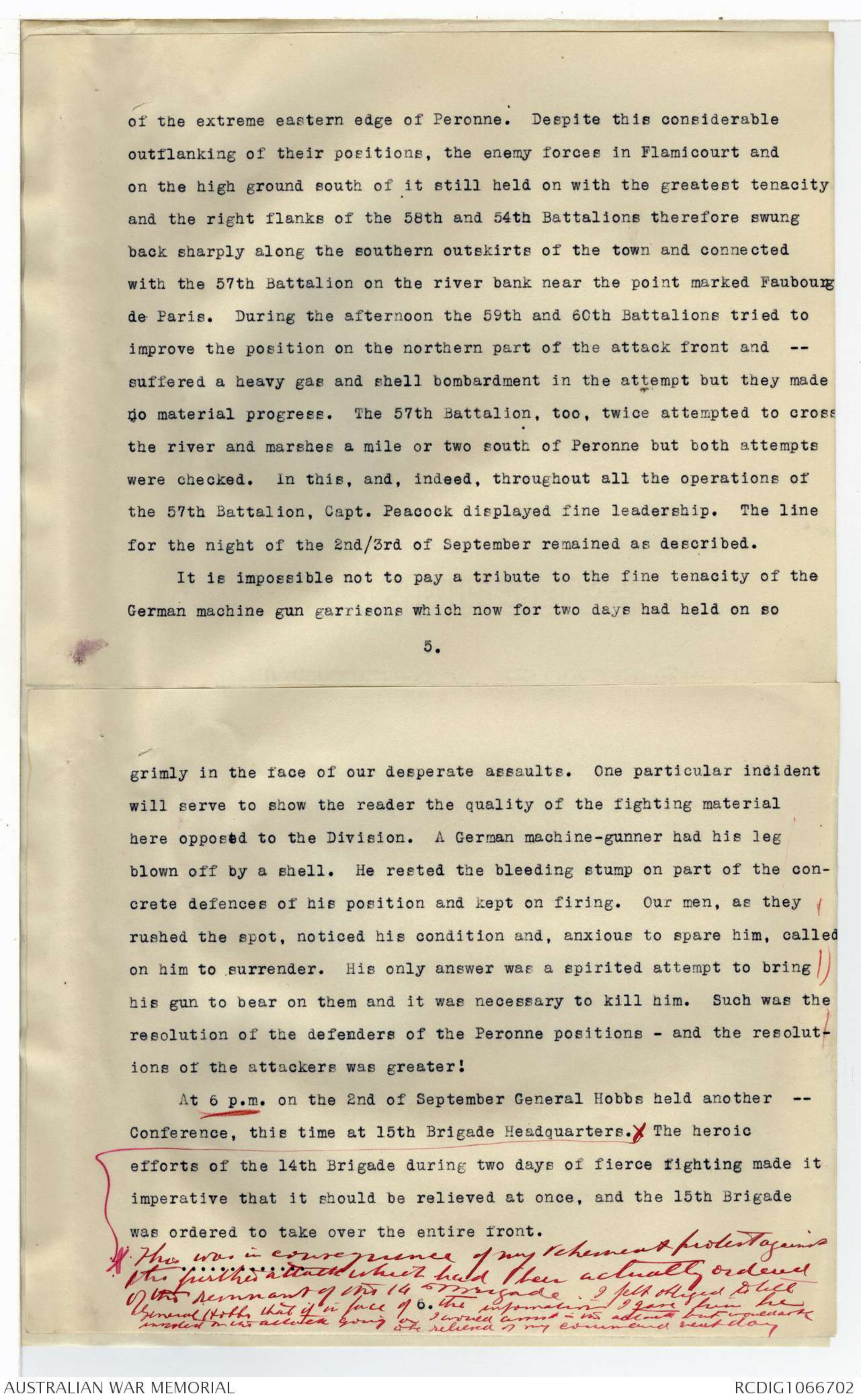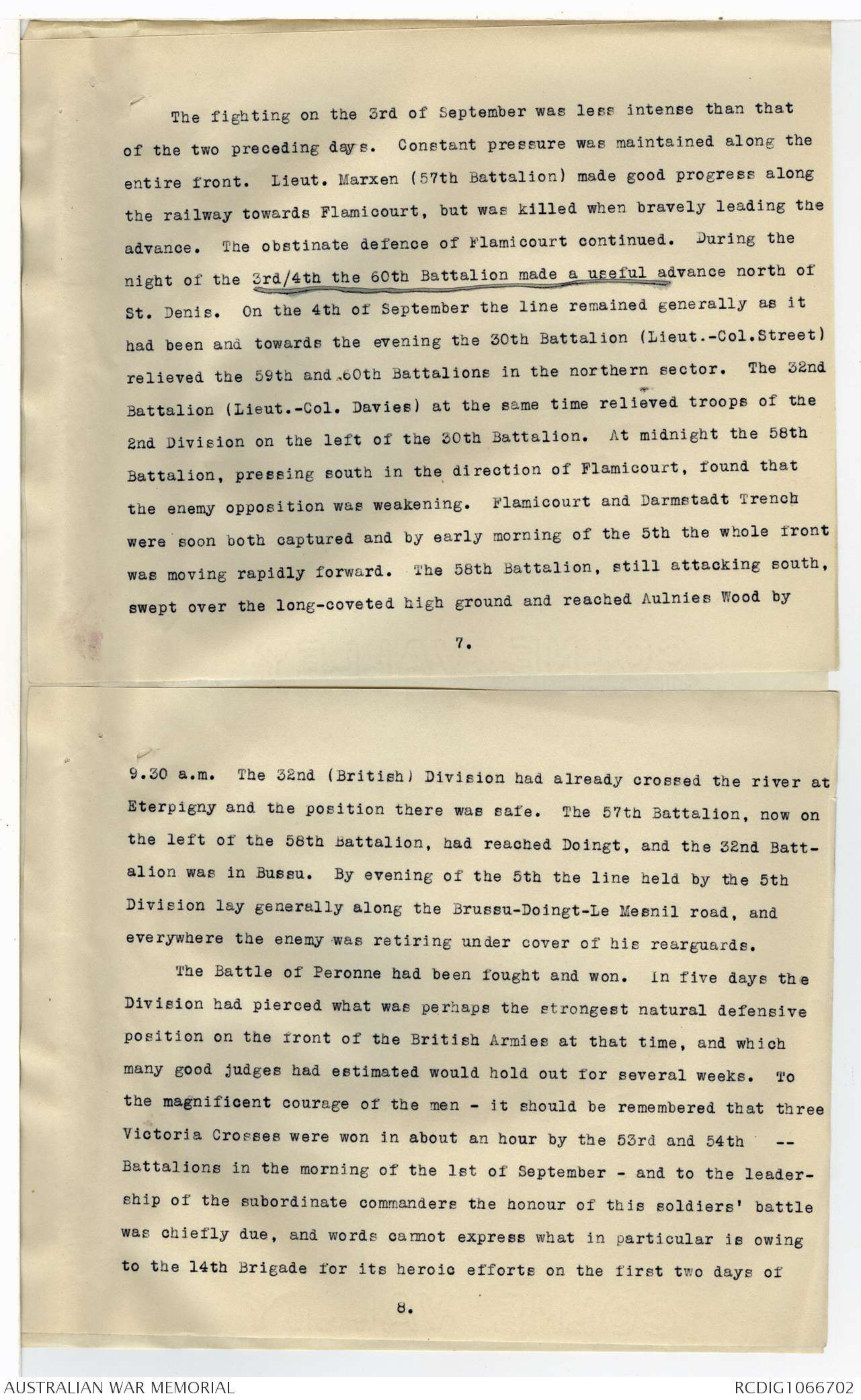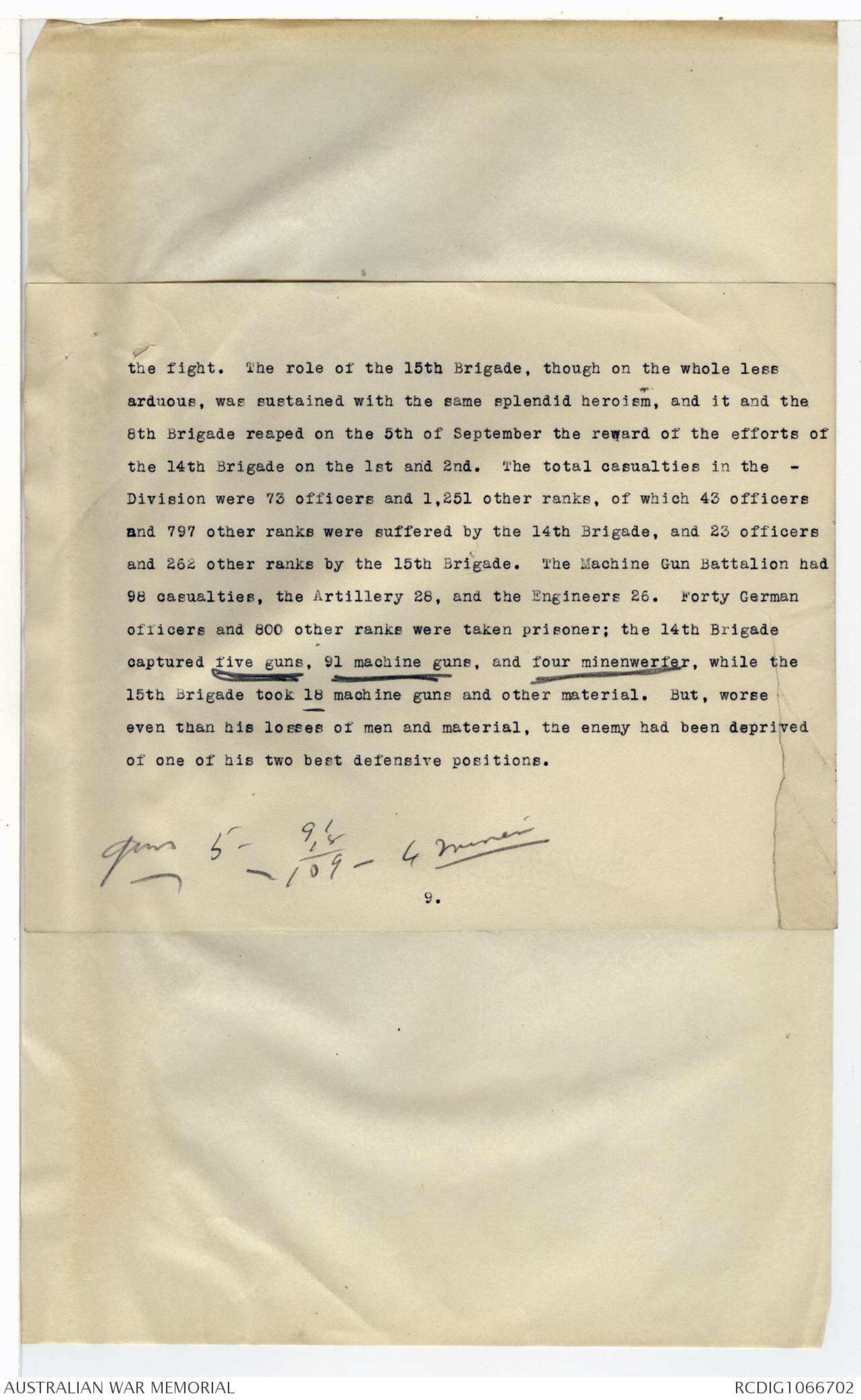Charles E W Bean, Diaries, AWM38 3DRL 606/266/1 - September 1918 - Part 6







54th Battalion had progressed steadily to the outskirts of the town,
the lower conformation of the ground affording it in the early stages
of the attack more security from machine gun fire, which the 53rd
Battalion had found so deadly. After hard fighting most of the enemy
defenders were forced back into the town and shortly after the last
party crossed the causeway it was blown up and, for a time, all --
attempts of the 54th to get forward were checked by machine gun fire
from positions near the ramparts and from the housetops. /At this
stage, and, indeed, throughout the entire operation; Cpl. A. C. Hall
displayed distinguished courage and initiative. Alone he rushed a
machine gun post that was holding up the advance, shooting four of
the enemy gunners as he charged forward and capturing nine others and
two machine guns. For this and similar exploits, he was awarded the
V.C. Not less magnificent was the work of Cpl. A. H. Buckley. He too.
single-handed, rushed an enemy strong point, killed four of its --
occupants and took 22 prisoners. A little later a machine gun position
13.
across one of the moats held up the advance of his company. A bridge
led across the moat, and Buckley, though he knew the attempt was almost
hopeless, dashed across the bridge towards the strong point and was
killed. He, too, was awarded the V.C. These and other instances of
dashing leadership eventually overcame all opposition outside the walls
and by 8.40 a.m. the Battalion, inspired by the personal direction of
Lieut.-Col. Marshall, had gained a good grip on the western half of the
town and the men were busy mopping up the extensive cellar defences,
which in many places held out strongly. In this work. Capt. Downing
rendered conspicuous service. Soon afterwards, the right of the 54th
Battalion established touch with part of the 59th Battalion (Lieut.-
Col. Scanlan) near the river bend.
. . ........
The front line of the 14th Brigade, despite its great exertions
earlier in the day, made another unsuccessful attempt to advance at
1 p.m. At 1.30 p.m., however, the position on the left was relieved
14.
considerably by the capture by the 2nd Division of the summit of Mt.St.
Quentin after a gallant attack by the 6th Brigade. At 3 p.m. a company
of the 56th Battalion pushed up and connected the right of the 53rd
Battalion with the left of the 54th in Peronne. Throughout the day the
work of Capt. C. H. Mann, of the 56th Battalion, had been of the
highest order, and now again he rendered notable service not only by
his personal gallantry, but also by his skilful leadership. The
position was so much easier in the latter part of the afternoon that
yet another advance was attempted by the 14th Brigade at 5 p.m. This
met with more success, and the line was advanced some hundreds of
yards east of the cemetery with advanced elements still further out.
The machine gun fire from the north-east ramparts of the town and from
the vicinity of St. Denis was, however, still most deadly, and at
8.15 p.m. General Stewart ordered the advanced elements to be withdrawn
so that a thorough artillery preparation of the entire area might be
carried out as the necessary prelude to further infantry attacks. The
15.
withdrawal was effected accordingly, and a line just east of the
cemetery was consolidated overnight. The 55th Battalion, meanwhile, had
linked up to the 2nd Australian Division on its left, and the order
of the battalions on the 5th Divisional front on the night of the
1st/2nd of September thus ran from north to south 55th, 53rd, 56th, 54th
and 57th (Lieut.-Col.Denehy) and the approximate line was as shown on
the map.
[* The map unfortunately is not in the book at all? [[Sellis?]] explained that
he could not [[??]] for the publication of the book and somehow this
handwritten map was omitted & in it's stead a map belonging to this 1917 advance got put in.*]
16.
[* night of 1/2*]
[*2nd Sept
Conference at 8th Brigade H.Q. in my absence. *]
[* Most importantly the conference concluded before I reached the headquarters H.G.E. *]
The Battle of Peronne.
Page 351.
The plan as finally decided on was to a great extent a continuation
of that adopted for the first day's operation, with the substitution of
fresher battalions in the attack and the direct assistance of the l4th
Brigade by the 15th. The attack north of Peronne was to be continued
on a lrontage of about 600 yards. The 56th Battalion, plus two compan-
ies of the 55th, was to carry this out on a one company front, the
jumping-off line being fixed on a general north and south direction
slightly east of the cemetery.
[* This was the arrangement when Steward left the conference.*]
The eastern objective was the ground in the vicinity of Darmstadt
Trench and to the east of it. The 54th Battalion was to extend its
hold on Peronne, the eastern half of which was still strongly held.
The 59th and 60th Battalions, the 60th commanded by Major Kerr, were to
follow behind the eastern attack of the 56th and 55th Battalions, and
when the last-named units had attained their eastern objective were to
[* This was arranged before myself & General Hobbs led the H.O. after my late arrival meantime Stewart had left under the impression that all the 15th Brigade was to do was to continue their efforts to get across river south of Perronne *]
face south and make for the high ground east of the river. The 58th
Battalion was to assist the 54th Battalion in clearing Peronne, while
the 57th Battalion on the true Divisional front west of the river was
to maintain close watch on the situation and to cross the river and -
occupy the high ground if the opportunity arose. General Stewart, when
he left the conference, understood that the whole of the 15th Brigade
attack was to take place across the river front south of Peronne, and
it was not until about two hours after zero that information of the
precise nature of the 15th Brigade co-operation reached him.
[* When I saw General Hobbs, I told him that if the arrangements made
to be carried out the 14th Brigade would be wiped out & [[XXXX??]] of was important to stop the operation made the suggestion to him to [[ defers who??]] *]
The 56th Battalion suffered heavy casualties from an enemy
bombardment just prior to Zero, and all the officers of three companies
became casualties before the attack opened. A hurricane machine gun
fire opened on the leading waves as the advance commenced. The enemy,
protected by the ramparts on the north-east of Peronne, had easily
withstood the artillery preparation, and the machine gun crews there
[* 15th Brigade across enemy front & thus gave some assistance to the 14th Brigade best I concur it simply as a part [[of folom hone??]] *]
2.
were still intact. Round about St. Denis and the brickwords the machine
gun detachments appeared to have heen reinforced during the night, and
the 56th Battalion casualties were heavy from the outset. Sgt. O'Connor
now took command of the remnants of one company and by the most skilful
and determined leadership progressed with it some 300 yards beyond the
jumping-off line. Here he dug in with a company reduced in strength to
35 other ranks. The two companies of the 55th Battalion, by working
round on the north side of the attack, managed to get further forward,
reaching an embankment some little distance in front of the brickworks.
At 7.45 a.m. parties of the 55th Battalion had stormed the brickworks
and gained a temporary footing in St. Denis. Capt. Pinkstone and Lieut.
Phillips did particularly fine work at this stage. O'Connor's dauntless
party still held on in its dangerous position, while the 59th Battalion
had moved forward on the right and linked up his line with that of
the 54th in Peronne. Meanwhile, the 54th and 58th Battalions had done
good work in the mopping up of Peronne. The machine gun garrisons there
3.
held on with their customary stubbornness and the fighting was bitter
and bloody, but the fresher 58th Battalion especially was not to be
denied, and, thanks largely to the dash of its men and the line leader-
ship of its officers, particularly Lieuts. Laing, Morrison, and -
Slaughter, the town was finally cleared. In this stage of the fight
four officers and 100 other ranks were taken prisoners by the 58th
Battalion and Major Ferres, though now wounded, continued to direct its
operations with his customary courage and resource. Lieut. J. Adams,
of the 54th Battalion, again displayed in this fighting the gallantry
which had made him conspicuous on the previous day.
By this time the 55th and 56th Battalions were so reduced in
strength that it was deemed advisable to use them as a single battalion.
Lieut.-Col. Woods accordingly took charge, and for some hours the line
remained stationary slightly west of the St. Denis - Mt. St. Quentin
Road. The 58th Battalion made slight additional progress during the
afternoon and linked up with the 55th and 56th Battalions just north
4.
of the extreme eastern edge of Peronne. Despite this considerable
outflanking of their positions, the enemy forces in Flamicourt and
on the high ground south of it still held on with the greatest tenacity
and the right flanks of the 58th and 54th Battalions therefore swung
back sharply along the southern outskirts of the town and connected
with the 57th Battalion on the river bank near the point marked Faubourg
de Paris. During the afternoon the 59th and 60th Battalions tried to
improve the position on the northern part of the attack front and --
suffered a heavy gas and shell bombardment in the attempt but they made
no material progress. The 57th Battalion, too, twice attempted to cross
the river and marshes a mile or two south of Peronne but both attempts
were checked. In this, and, indeed, throughout all the operations of
the 57th Battalion, Capt. Peacock displayed fine leadership. The line
for the night of the 2nd/3rd of September remained as described.
It is impossible not to pay a tribute to the fine tenacity of the
German machine gun garrisons which now for two days had held on so
5.
grimly in the face of our desperate assaults. One particular incident
will serve to show the reader the quality of the fighting material
here opposed to the Division. A German machine-gunner had his leg
blown off by a shell. He rested the bleeding stump on part of the con-
crete defences of his position and kept on firing. Our men, as they
rushed the spot, noticed his condition and, anxious to spare him, called
on him to surrender. His only answer was a spirited attempt to bring,
his gun to bear on them and it was necessary to kill him. Such was the
resolution of the defenders of the Peronne positions - and the resolut-
ions of the attackers was greater!
At 6 p.m. on the 2nd of September General Hobbs held another –-
Conference, this time at 15th Brigade Headquarters. The heroic
efforts of the 14th Brigade during two days of fierce fighting made it
imperative that it should be relieved at once, and the 15th Brigade
was ordered to take over the entire front.
[* This was in consequence of my vehement protest against the further attack which had been actually ordered of the remnant of the 14th Brigade. I felt obliged to tell General Hobbs that if in face of the information I gave him he [[XXX??]] on his action going on I would assume in [[??]] but [[??] he relieved me of my command next day *]
The fighting on the 3rd of September was less intense than that
of the two preceding days. Constant pressure was maintained along the
entire front. Lieut. Marxen (57th Battalion) made good progress along
the railway towards Flamicourt, but was killed when bravely leading the
advance. The obstinate defence of Flamicourt continued. During the
night of the 3rd/4th the 60th Battalion made a useful advance north of
St. Denis. On the 4th of September the line remained generally as it
had been and towards the evening the 30th Battalion (Lieut.-Col. Street)
relieved the 59th and.60th Battalions in the northern sector. The 32nd
Battalion (Lieut.-Col. Davies) at the same time relieved troops of the
2nd Division on the left of the 30th Battalion. At midnight the 58th
Battalion, pressing south in the direction of Flamicourt, found that
the enemy opposition was weakening. Flamicourt and Darmstadt Trench
were soon both captured and by early morning of the 5th the whole front
was moving rapidly forward. The 58th Battalion, still attacking south,
swept over the long-coveted high ground and reached Aulnies Wood by
7.
9.30 a.m. The 32nd (British) Division had already crossed the river at
Eterpigny and the position there was safe. The 57th Battalion, now on
the left of the 58th Battalion, had reached Doingt, and the 32nd Battalion
was in Bussu. By evening of the 5th the line held by the 5th
Division lay generally along the Brussu-Doingt-Le Mesnil road, and
everywhere the enemy was retiring under cover of his rearguards.
The Battle of Peronne had been fought and won. In five days the
Division had pierced what was perhaps the strongest natural defensive
position on the front of the British Armies at that time, and which
many good judges had estimated would hold out for several weeks. To
the magnificent courage of the men - it should be remembered that three
Victoria Crosses were won in about an hour by the 53rd and 54th
Battalions in the morning of the 1st of September - and to the leader-
ship of the subordinate commanders the honour of this soldiers' battle
was chiefly due, and words cannot express what in particular is owing
to the 14th Brigade for its heroic efforts on the first two days of
8.
the fight. The role of the 15th Brigade, though on the whole less
arduous, was sustained with the same splendid heroism, and it and the
8th Brigade reaped on the 5th of September the reward of the efforts of
the 14th Brigade on the 1st and 2nd. The total casualties in the -
Division were 73 officers and 1,251 other ranks, of which 43 officers
and 797 other ranks were suffered by the 14th Brigade, and 23 officers
and 262 other ranks by the 15th Brigade. The Machine Gun Battalion had
98 casualties, the Artillery 28, and the Engineers 26. Forty German
officers and 800 other ranks were taken prisoner; the l4th Brigade
captured five guns. 91 machine guns, and four minenwerfer, while the
15th Brigade took 18 machine guns and other material. But, worse
even than his losses of men and material, the enemy had been deprived
of one of his two best defensive positions.
Guns 5 - 91
18
---109 - 6 machines
9.
 Sam scott
Sam scottThis transcription item is now locked to you for editing. To release the lock either Save your changes or Cancel.
This lock will be automatically released after 60 minutes of inactivity.